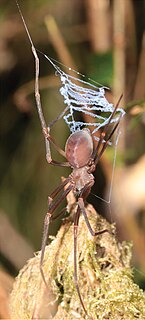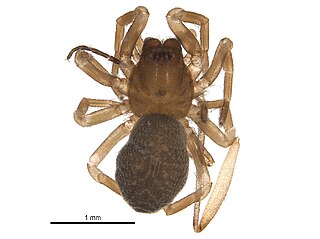
Titanoecidae is a family of araneomorph spiders first described by Pekka T. Lehtinen in 1967. It is fairly widespread in the New World and Eurasia with five genera and more than 50 species worldwide. These are mostly dark-colored builders of "woolly" (cribellate) silk webs. Several species are found at relatively high altitudes in mountain ranges and may be very common in such habitats.

Cribellum literally means "little sieve", and in biology the term generally applies to anatomical structures in the form of tiny perforated plates.

Nigma is a genus of cribellate araneomorph spiders in the family Dictynidae, and was first described by Pekka T. Lehtinen in 1967. They have a wide distribution, including Eurasia, North America, and Northern Africa. N. walckenaeri is one of the biggest members of the Dictynidae, growing up to 5 millimetres (0.20 in) long. They are translucent green and sometimes have red or black markings on the abdomen.
Mexitlia is a genus of North American cribellate araneomorph spiders in the family Dictynidae, and was first described by Pekka T. Lehtinen in 1967. As of May 2019 it contains only three species: M. altima, M. grandis, and M. trivittata.
Chorizomma is a monotypic genus of European dwarf sheet spiders containing the single species, Chorizomma subterraneum. It was first described by Eugène Simon in 1872, and has only been found in Spain and France. Originally placed with the funnel weavers, it was moved to the Dictynidae in 1967, and to the Hahniidae in 2017.
Arushina is a monotypic genus of East African corinnid sac spiders containing the single species, Arushina dentichelis. It was first described by Lodovico di Caporiacco in 1947, and has only been found in Tanzania. Originally placed with the Dictynidae, it was moved to the Ant spiders in 1967, to the Sac spiders in 1991, then to the Corrinid sac spiders in 2000.

Cybaeina is a genus of North American araneomorph spiders in the family Cybaeidae, and was first described by R. V. Chamberlin & Wilton Ivie in 1932. Originally described from a single female found in Olympia, Washington, it was placed with the Cybaeidae in 1967.

Cybaeota is a genus of North American araneomorph spiders in the family Cybaeidae, and was first described by R. V. Chamberlin & Wilton Ivie in 1933. It was moved to the Cybaeidae in 1967.
Cybaeozyga is a monotypic genus of North American araneomorph spiders in the family Cybaeidae containing the single species, Cybaeozyga heterops. It was first described by R. V. Chamberlin & Wilton Ivie in 1937, and was moved to the Cybaeidae in 1967. It has only been found in United States.
Arangina is a genus of South Pacific cribellate araneomorph spiders in the family Dictynidae, and was first described by Pekka T. Lehtinen in 1967. As of May 2019 it contains only two species, both found in New Zealand: A. cornigera and A. pluva.

Blabomma is a genus of araneomorph spiders in the family Cybaeidae, and was first described by R. V. Chamberlin & Wilton Ivie in 1937. Originally placed with the funnel weavers, it was moved to the Dictynidae in 1967, and to the Cybaeidae in 2017.
Devade is a genus of cribellate araneomorph spiders in the family Dictynidae, and was first described by Eugène Simon in 1884. Originally placed with the Amaurobiidae, it was moved to the intertidal spiders in 1983, then to the Dictynidae in 1989.

Hackmania is a genus of cribellate araneomorph spiders in the family Dictynidae, and was first described by Pekka T. Lehtinen in 1967. As of May 2019 it contains only two species: H. prominula and H. saphes.
Marilynia is a genus of cribellate araneomorph spiders in the family Dictynidae, and was first described by Pekka T. Lehtinen in 1967. As of May 2019 it contains only two species: M. bicolor and M. bicolor.
Mashimo is a monotypic genus of East African cribellate araneomorph spiders in the family Dictynidae containing the single species, Mashimo leleupi. It was first described by Pekka T. Lehtinen in 1967, and has only been found in Zambia.
Tahuantina is a monotypic genus of South American cribellate araneomorph spiders in the family Dictynidae containing the single species, Tahuantina zapfeae. It was first described by Pekka T. Lehtinen in 1967, and has only been found in Chile.
Yorima is a genus of araneomorph spiders in the family Cybaeidae, and was first described by R. V. Chamberlin & Wilton Ivie in 1942. Originally placed in the funnel weaver family, it was moved to the Dictynidae in 1967, and to the Cybaeidae in 2017.
Dirksia is a genus of araneomorph spiders in the family Cybaeidae, and was first described by R. V. Chamberlin & Wilton Ivie in 1942 as a subgenus of Ethobuella. Originally placed with the funnel weavers, it was elevated to genus and moved to the dwarf sheet spiders in 1967, then moved to the Cybaeidae in 2017. As of May 2019 it contains only two species: D. cinctipes and D. pyrenaea.
Ethobuella is a genus of North American araneomorph spiders in the family Cybaeidae, and was first described by R. V. Chamberlin & Wilton Ivie in 1937. As of May 2019 it contains only two species: E. hespera and E. tuonops. Originally placed with the funnel weavers, it was elevated to genus and moved to the dwarf sheet spiders in 1967, then moved to the Cybaeidae in 2017.
Shango capicola is a species of African cribellate araneomorph spiders in the family Dictynidae. It is the only species in the monotypic genus Shango. The genus was first described by Pekka T. Lehtinen in 1967, and has only been found in South Africa.






